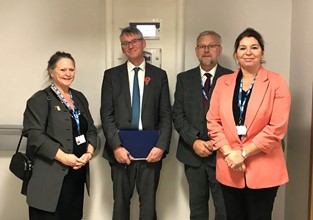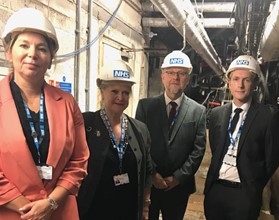Doncaster and Bassetlaw Teaching Hospitals NHS Foundation Trust is one of Yorkshire's leading acute trusts serving a population of more than 420,000 across South Yorkshire North Nottinghamshire and the surrounding areas. It employs over 6000 staff members, with three hospitals in Doncaster, Bassetlaw and Mexborough.
On arrival, I was greeted by the trust’s chief executive, Richard Parker, and chair, Suzy Brain England, and received a warm South Yorkshire welcome from their executive and non-executive board colleagues.
Following the previous evening's annual Star Awards, which celebrated its staff's exceptional achievements, we discussed the importance of staff recognition in the current challenging conditions where industrial action has created tensions and a dip in morale. We also talked about the trust’s big challenges and opportunities, including urgent care demand, financial pressures, elective recovery, system working, provider partnerships, and governors’ current and future role in NHS Foundation Trusts.
The main topic of conversation, however, which framed the visit, was the trust’s need for major capital investment, given it is no longer within the New Hospitals Programme and has urgent backlog maintenance and fire safety requirements given its ageing estate and infrastructure. The team stressed how this situation is a real impediment to greater quality, efficiency and productivity, as well as the elevated risks of infrastructure failure. Despite this challenge, the trust has taken action to prioritise developing key projects, including investing £56m in vital upgrades. For example, the community diagnostic centre and elective orthopaedic centre at Montague hospital, an emergency village at Bassetlaw hospital, and a new central delivery suite at Doncaster royal Infirmary.
However, to exemplify the urgent need for a significant capital overhaul of the trust’s main Doncaster site, I was taken on a tour of the Doncaster Royal Infirmary, where I saw first-hand some of the major challenges and issues faced by the trust. Doncaster's east ward is a large 1960s tower block reliant on lifts to transport patients and staff. The trust has had reliability problems with these lifts and occasions when only one lift was functioning while parts were awaited to fix the other three.


In addition, water leakage and consequent ceiling collapses have occurred due to the ageing infrastructure. In April 2021, the Women’s and Children’s Hospital suffered a major water leak, which required a big evacuation of staff and patients and an extensive recovery effort to restore services and large-scale remedial works. The team described to me the fear and anxiety but also the heroic and quick-thinking actions of the staff to ensure no patients or team member were harmed during this incident. This is a good example of the importance of tackling the scale of backlog maintenance at Doncaster and across much of the NHS.
Capacity is also a problem at the hospital as its emergency department, designed for 200 patients, regularly sees double that and up to 500 on the most pressurised days. There are also big distances for staff and patients to move between ward areas and theatres, with patients having to be transported through underground service corridors past laundry and waste bins. The team has done its best to mitigate the sub-optimal environment. Still, the current hospital layout seriously compromises patient experience and the efficient use of staff time. Though a new site for the hospital would benefit the wider South Yorkshire hospital system, the trust is not part of the the New Hospitals Programme and therefore an alternative plan of refurbishing the East Ward Block is being worked up.
The team at the trust are entirely focused on the key clinical, operational and financial challenges; however, the inadequate and ageing capital infrastructure across the hospital estate needs to be improved in their ability to respond to these. As such, it is vital that solutions are found to help resolve the current difficulties so that the trust can realise its great potential.
It was clear to me that resolving these issues is the number one priority for the trust. Doing so would significantly boost their vital work on improvement, values and behaviours and system working.
About the author

